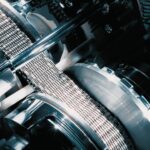Modern cars are getting easier and easier to operate. Take the parking brake as an example. Electronic ones have replaced the manual parking brakes of old. If you have a modern car, it should now be fitted with an electric parking brake (EPB). What is an electric parking brake?
Electric or electronic parking brakes (EPB) work in the same way as manual handbrakes. The only difference is that they use electric motors to achieve the same effect. If you press the EPB button on the console, the motors on the car’s rear brakes will press the brake pads into their respective discs. You will hear the whirring sound of the motors once you activate the EPB.
Electric parking brakes are safe, perhaps even safer than manual parking brakes. They offer solid holding stability on parked vehicles. You can manually engage some of them, just like the old ones, while you can automatically activate others once you turn off the ignition.
Read on to learn more about electronic parking brakes, how they work, how they compare with manual parking brakes, and their pros and cons.
What Is an Electric Parking Brake?

Electric (or electronic) parking brakes work like normal manual handbrakes, except electric motors achieve the effect. Press or pull a button, and motors on the rear brakes will press pads onto the discs.
Most modern cars have electric parking brakes. You’ll notice that these brakes are not much different than the manual handbrakes present in older vehicles. The initial force that activates the system is provided, not by hand but by electric motors.
Handbrake Lever
In the old model, the driver pulls up the handbrake lever, and the brake pads at the rear wheels press on their respective discs, which then holds the tires securely.
Electric Parking Brake (EBP)
With the EBP, you only need to push the electronic parking brake button, and the electric motors will do the rest. The only action you take is to push or pull the button. An activated parking break will produce a whirring sound when the parking brake is being set.
Most automotive experts believe that this modern system is safer than the manually operated handbrake. Additionally, electronic parking brakes with ‘auto-hold’ are able to apply the brakes in an emergency situation.
The first cars that used electronic parking brakes are those made by BMW of Germany. BMW first installed EPBs on its BMW 7 Series (E65) 2001 models. Since then, major automakers around the world have followed suit.
What Does Park Assist Blocked Mean?
How Does an Electric Parking Brake Work?
Electronic parking brakes work in the same way as manual handbrakes. A cable connects the handbrake lever to the brake pads or shoes on the rear wheels’ brake discs or drums in the manual version.
When you pull the lever, the brake pads engage the drums or discs, and the vehicle will not move. If you release the lever, you’ll also release the brake pads on the rear wheels’ discs.
Electronic parking brakes activate the brake pads and discs on the rear wheels as well.
Components of an Electric Parking Brake
Instead of a cable, modern Electric Parking Brakes use the following components:
- Electronic brake modules
- Electric motors or actuators
- Button or electric switch on the console
When you press the electronic parking brake button or switch, the electronic brake module receives a signal. The signal will give the command for the engagement of parking brakes.
The electronic brake module then sends a signal to the electric motors or actuators installed in the brake calipers to engage. This induces the brake pads to stick to the disc, preventing the rear wheels and the vehicle from moving.
With the use of electronic components and electric motors, activating modern vehicles’ parking systems is now almost instant and more efficient. And in the absence of any mechanical connection, there’s an enhancement of the parking brake system’s reliability.
It is also more convenient because when the driver puts his foot on the accelerator pedal, the parking brake automatically disengages. The problem of unreleased park brakes while running the car is no longer a worry of forgetful drivers.
A welcome addition to electronic parking brakes is the hill start assist feature. There are car manufacturers who have added this feature to their electronic parking brake systems. If you are having some difficulty starting at a stop on a hill, you will love this feature.
It will reduce your stress because, with this feature, your hill starts will be much easier.
Electric Parking Brake Problems [Causes and How to Fix]
How to Operate the Electronic Parking Brake
You can operate the electronic parking brake system manually or automatically. In most electronic parking brake systems, an indicator light turns on when the system is switched on. This light also goes off when you release the parking brakes.

As with manual handbrakes, the same rules apply:
- You need to make sure that the parking brakes are on release before driving the vehicle. Also, ensure that the electronic parking brake indicator light on the dashboard is off;
- You need to apply the parking brake before leaving your vehicle; and
- Make sure that the electronic parking brake indicator light is on before you leave your vehicle.
If your car has an electronic parking brake, here’s a video that will show you how to operate it.
Tips When Operating an Electronic Parking Brake
Here are some useful tips for operating the electronic parking brake of your car:
- Before turning off the ignition key, apply the parking brake manually. Just push the button to activate it;
- When the system is on, you’ll hear a whirring sound from the motor to indicate the system’s engagement. This noise will stop in just a few seconds once you engaged the parking brake. It will be the same noise you will hear when you release the parking brake. Don’t worry because this is just normal;
- If the charging system warning light (in the instrument cluster) turns on, you cannot activate the electronic parking brake system cannot be activated even if you switch off the ignition;
- If you haven’t used the electronic parking brake for a long time, you need to have it inspected by a qualified mechanic to ensure that it is still working;
- The brake pedal may move when you apply or release the electronic parking brake. Don’t worry, as this is just normal;
- If you experience a problem with the foot brake while driving your car, pull up the electronic parking brake switch continuously. This will apply the brakes and slow down your vehicle or even stop it if you wish to. You will hear the whirring sound as you do this, but the sound will stop once you release the switch;
- When the ignition is off and you apply the parking brake system, the electronic parking brake indicator light in the switch and its indicator light on the instrument cluster may turn on for about 15 seconds; and
- When placing your vehicle in a car wash with the front tires mounted and the vehicle moving, it is important to cancel the electronic parking brake’s automatic operation before the car washing process starts.
Why Is the Brake Warning Light Coming on On My Dashboard?
Electric Vs Manual Parking Brake
Manual Brake
Which is better, electronic parking brakes or manual handbrakes? Manual versions use physical cables to prevent vehicles from moving, while electrical versions use electronic components to achieve the same effect.
The former does not require electric motors but requires force to activate, while the latter does not require a physical effort but requires electric power to operate.
Electronic Parking Brake
It is more convenient to operate electronic parking brakes than manual handbrakes. But if there is no power, you can’t activate it. In contrast, you can engage a manual handbrake anytime.
Whether you like it or not, most modern cars have electronic parking brakes. With the advent of modern technology, there will come a time when manual handbrakes will just become things of the past.
As it is, only entry-level vehicles have manual park brakes. Their higher trim models more than likely will have modern electronic parking brakes. It may be possible to upgrade your vehicle’s parking brake to EPB, but that will cost you money.
Pros and Cons of an Electronic Parking Brake
Pros
- An electronic parking brake eliminates all physical effort to park a vehicle safely. This will be very beneficial to those who are physically challenged or differently abled.
- The response time of electronic parking brakes is short. That means the car is secured immediately after pushing the electronic parking brake switch.
- Electronic parking brakes also save up space inside car cabins. The usual space allocated for manual handbrake components will be open for more storage space for car owners who have more electronics and other gadgets to carry with them these days.
Newer vehicles with electronic parking brakes now have more cup holders and gadget storage space between the driver and the front passenger.

- There are no mechanical parts to maintain in electronic parking brakes.
- You can depend on the electronic parking brake of your vehicle all the time.
- The vehicle’s electronic parking brake is firmer, more secure, and stronger because the force applied is not provided by a stretchable cable. It is a steady force applied by calibrated and controlled electronic components.
- It improves your control of the vehicle if you are starting from a stop on a hill.
- The electronic parking brake can be used as an emergency backup braking system should the vehicle’s onboard braking system fails.
Cons
- Electronic parking brakes are generally more expensive than their manual counterparts.
- The size of the switch or button is not as large as the lever of the manual handbrakes. It takes time to get used to it.
- It is more expensive to have your car’s electronic parking brake repaired if it manifests operational problems.
This braking system consists of special electronic components, and only qualified car technicians specializing in them could get them to work properly. Special car diagnostics go into their repairs, and that costs quite a lot.
- The brake pads of electronic parking brakes tend to stick if they are not used for a long time. Some car owners have left their cars on parking brakes for several days, and when they go back, the EPBs won’t disengage.
If the vehicle with an EPB is an off-roader, and the owner often goes off the road, the brakes will accumulate dirt or even mud. This will cause the brakes to stick to the discs.
- Electronic parking brakes that are automatically activated go into action even when they forget to switch it on. That means you don’t have the freedom to choose whether to switch it on or not.
Pros and Cons of a Manual Parking Brake
Pros
- Manual handbrakes are simple to operate and are reliable. Given proper care and maintenance, they will function properly every time;
- Repairing manual park brakes is not very expensive. They consist of mechanical parts, which are not very costly to repair. Weekend mechanics can even fix their parking brakes by themselves. Parts of manual parking systems are easier to find and are cheaper as well;
- Cars with manual handbrakes allow their drivers to perform handbrake turns. This is a stunt that you can’t do with electronic parking brake cars. In other words, those who are fond of showing off their car skills will be limited if they install EPBs on their cars; and
- Grabbing a lever is easier in emergencies than looking for the right switch to push.
Cons
- In an emergency, the driver may panic and pull the lever. This will lock the rear wheel and send the vehicle out of control;
- Manual handbrakes take up too much space in the cabin. They consist of mechanical parts, many of which are located inside the cabin;
- They are not as reliable as EPBs because. The cable will stretch over time and compromise its hold on the vehicle;
- There is a greater chance for wear and tear of the mechanical parts, leading to the parking brake system’s failure;
- Certain parts of the manual braking system are weak points that can cause the system to fail. These are the cable and the ratchet; and
- Manual parking brakes need to be checked and serviced often to ensure the cable’s right amount of tension.
Conclusion: Electronic Parking Brake
Electronic or electric parking brakes work on the same principle as the old manual handbrakes. The major difference is that electric motors are used instead of manual force to achieve the same effect.
Once you press or pull the electronic parking brake button on the car’s console, the motors on the rear of the car will press or pull the brake pads into or out of their respective brake pads. You know that the electronic parking brake is activated if you hear the whirring sounds of the motors.
If you’re looking for a simple to operate and reliable parking brake, you can rely on manual handbraked. However, one of the downsides is that you or your driver may accidentally pull the lever in case of an emergency.
In this case, you may choose EPB since it does not require physical effort to park your vehicle safely.
Related reading:
Brake Pedal Goes to Floor When Engine Running [How to Fix]
Brake Lights Won’t Turn Off [Causes and How to Fix]
Grinding Noise When Braking [9 Possible Causes and How to Fix]

![Electric Parking Brake Problems [Causes and How to Fix] electric parking brake problems](https://roadsumo.com/wp-content/uploads/2022/05/electric-parking-brake-problems-150x150.jpg)


![How Does Vroom Work? [Buying and Selling] how does vroom work](https://roadsumo.com/wp-content/uploads/2022/04/how-does-Vroom-work-150x150.jpg)




![Read more about the article Nissan Key Fob Battery Replacement – [How to Change It?]](https://roadsumo.com/wp-content/uploads/2022/11/Nissan-key-fob-battery-replacement-300x200.jpg)